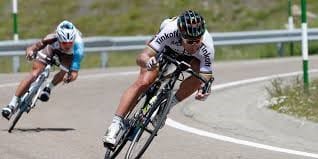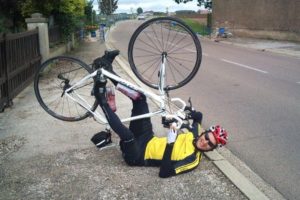Getting Down, Safe and Sound
A Scaredy-Cat’s Guide to Safe Descending

The ability to ride in mountainous terrain defines a road cyclist. While much attention is given to the suffering and training associated with getting up a climb, many novice cyclists rarely receive any guidance on getting down the hill. The process seems simple until you are hurtling down a mountain in excess of 40 mph dressed in little more than your underwear and a styrofoam cup on your head.
Oh, and then there is that issue of doing this surrounded by other cyclists, other vehicles and road conditions.
During my racing career some credited me with being a good descender. While I’m flattered, I got to race alongside true “falcons” such as Alvaro Pino of Spain and Sean Kelly of Ireland, both of whom are worth reading about. The recent exploits of Fabian Cancellara amaze me on video. Current stars Peter Sagan and Romain Bardet (see picture above, which exemplifies perfect form) have pushed the art of descending to a new level.
Now that I’ve bragged, here is my confession: I’m actually a scaredy-cat when it comes to risk. I’ve hit the floor enough for one lifetime to dissuade my taking many more chances.
So why is it I go so fast? In many ways – and this may seem counterintuitive – faster is safer.
The advent of hydraulic disc brakes with through-axle wheels change much of the strategy around mountain descents, especially in wet conditions. Those brake have also allowed clearance for wider tires that can run at a softer pressure, which vastly improves traction in turns. Also getting to ride a BMC Team Machine, with its short wheelbase (the distance between the front and rear hub), is a huge advantage.
Here are 10 tips to being smooth and safe on fast descents.
- Look Way Ahead. The NASCAR legend Cale Yarborough always spoke of looking WAY down the track. This is key in cycling. One can not only see the turns, the pavement condition, and gradients but other indicators such as turn signs and speed limits which are critical. The advent of GPS navigation also allows us to glance down at the course for any major turns ahead, but mind you it’s only a glance during safe straightaways.
- Master the Attack Position. This title intimidates people, but it is really about safety not speed. This is the position refined by mountain bikers and cyclo-cross racers to drop into perilous grades. To do so, move the body back on the saddle and down low, with the knees and elbows bent to serve as suspension. THIS IS NOT about being aero and fast, which intimidates novices; this is about making you stable to manage safe braking, turning, and the chance encounter of rough pavement or debris. How low? I never thought of this until I started teaching. I often will go so low as to have the nose of my saddle touch my sternum. (Again, see the picture above. Their position is not about speed so much as safety and stability.)
- Find the Late Apex. Too many riders dive into sharp corners too early only to find a tightening radius that forces them out of their line, grabbing brakes and into risky circumstances. Good descenders enter the turn “late” when they know the apex is safe and the exit secure. This is especially true with several turns. Entering a sequence of turns poorly complicates each turn thereafter.
- Keep the Power Down. As one enters the turn try to keep pedaling so the back wheel maintains traction, being careful not to put the inside pedal too low. Even when feathering the brakes, good descenders will keep softly pedaling, an advanced skill known as “power braking.”
- Outside Pedal; Inside Hand. On turns so sharp that one cannot pedal through so not to touch the inside pedal on the ground, novices learn to press down hard, like REALLY hard, on the outside pedal at the bottom of the pedal stroke. But pros learn to also keep pressure on the inside hand, which stabilizes the front wheel almost like a rudder to guide the bike exactly where you want it to go. (Refer back to tip number 1.)
- Brake Before You Need To. A good descender will brake sparingly but wisely. Before you enter a sharp turn take the speed off with both brakes, using the above tips to control the bike. But as you enter the turn lay off the front brake to avoid catastrophe. If you are still going too fast, feather the rear brake….and employ tip number 7.
- Lean the Body, Not Just the Bike. This is a piece of advice downhill mountain bike racers provide to roadies. While leaning the bike is essential, one can lean the body slightly further than the bike which allows one to feather a rear brake and drive the bike safely out of a tight turn at speed.
- DO NOT SHOW OFF! This is the biggest mistake made by charity riders and novices. (And almost always men.) Things can go terribly wrong on descents. As The Door’s song states: “Keep Your Eyes on the Road and Your Hands Upon the Wheel.” The organizers of the Best Buddies Challenge work hard to produce the safest charity ride in America. The very few crashes in recent editions that resulted in injury were the result of riders breaking this rule.
- Let It Roll. A well maintained modern bike rolls pretty safe and smooth with a good pilot. Too many beginners fight the bike and seem to box their way down the hill, grabbing too much brake and riding in a panicked, tense fashion. The bike is more stable when it is rolling smoothly. Let it Roll. (Hey, there’s that Door’s song again!)
- Relax. Using all that stuff above, try to relax, breathe and have some good clean fun. If you master those nine tips above, you’ll likely enjoy miles and miles of safe, exhilarating downhill fun.
 Richard Fries is the Director of Cycling Experience for the Best Buddies Challenges. With more than 40 years experience, he has been a racer, commuter, tourist, promoter, advocate, journalist and commentator on the sport and lifestyle of cycling. Having raced at the professional level both in America and Europe, Fries is well known as a race announcer having called countless USA Cycling National Championships, World Cups, and UCI World Championships. But he is also a tireless advocate having recently served as the executive director of MassBike. You can follow him on Strava to learn more.
Richard Fries is the Director of Cycling Experience for the Best Buddies Challenges. With more than 40 years experience, he has been a racer, commuter, tourist, promoter, advocate, journalist and commentator on the sport and lifestyle of cycling. Having raced at the professional level both in America and Europe, Fries is well known as a race announcer having called countless USA Cycling National Championships, World Cups, and UCI World Championships. But he is also a tireless advocate having recently served as the executive director of MassBike. You can follow him on Strava to learn more.





